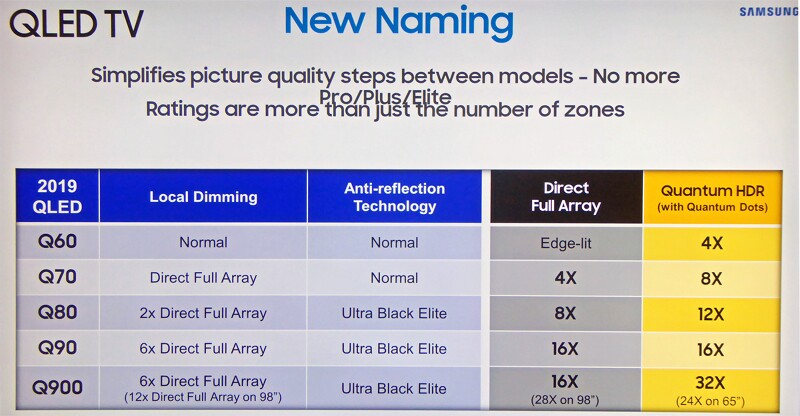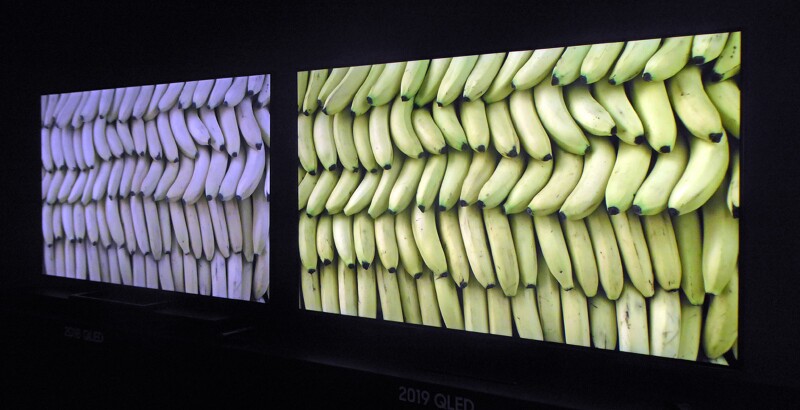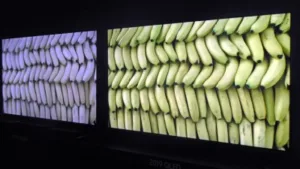Last Thursday, I traveled up to Samsung’s QA Labs in Pine Brook, NJ to get the “skinny” on the company’s 2019 TV lineup. The event was very much low-key, taking place in one of the testing labs with several TVs set up around the side of the room, folding chairs for the press, and sandwiches, salad, and cookies on paper plates from Panera.

It wasn’t that many years ago that Samsung would officially unveil that year’s TV lineup with elaborate parties at upscale New York City restaurants and venues (I remember drinking a Bellini or two at the curved OLED TV launch in 2013 at Cipriani). One year, the event even took place in the Rainbow Room atop the RCA Building! In more recent years, Samsung chose to stage the event at their 837 Washington Street showroom/theater/venue.
Perhaps it’s a sign of the times that TV line shows are not the big deals they once were, given the collapsing prices for Ultra HD sets. (You can find good 55- and 60-inch models for $5 – $6 per diagonal inch now.) Even so, Samsung is still king of the TV hill and this press event served to remind everyone that the company – who has been making a lot of noise about 8K TV lately – still has a full lineup of Ultra HD televisions, including many premium models.
Give the Customers What They Want
If there was an overarching theme this year, it was “give the customers what they want!” Samsung reps told us that most of the features and SKUs in the 2019 line-up were due to customer feedback. Example: Of the seven model categories showcased (RU7, RU8, Q60, Q70, Q80, Q90, and Q900), each one has a 75-inch model in the line. Certainly, you can’t argue with the fact that consumers want bigger screens, as the median TV size seems to have slipped by 55 inches and is closing in on 60 inches.
Samsung also says, “we make TVs for every passion point!” The RU7 series is described as targeting cord-cutters and streaming enthusiasts, while the step-up Q60/RU8 series should appeal to value-minded purchasers. (I’m not sure you can draw a line between “value-minded” buyers and cord-cutters, who are obviously VERY value-minded.)
The Q80/70 line is aimed at “enthusiasts with high expectations,” while the top of the line Q90/Q900 sets are for those buyers “looking for the latest and greatest.” I should mention that the price differential between a 65-inch UN65RU7100 smart TV and the step-up UN65RU8000 is all of $500, a gap that could close easily in event of a sale or promotion.
Where things get more interesting is in the 2019 QLED lineup. The Q60 models employ a conventional local dimming backlight with “normal” anti-reflection coatings. (You can still see screen reflections with bright lights.) The Q70 series moves to a direct full array backlight with the same screen coating. But step up to the Q80 line, and you now have a 2x direct full backlight array with Ultra Black Elite (UBE) anti-reflection screens. The Q90 line expands that to a 6x direct full backlight array with UBE, as do the Q900 8K models. (The 98-inch Q900 has a 12x direct full array with UBE.)
 This chart is supposed to show how consumers like to “brand” the differences between the 2019 RU- and Q-series Ultra HDTVs. One week later, I still don’t understand it.
This chart is supposed to show how consumers like to “brand” the differences between the 2019 RU- and Q-series Ultra HDTVs. One week later, I still don’t understand it.
Samsung then proceeded to confuse most of us with a new system of picture quality ratings that (supposedly) consumers said they preferred. The aforementioned Q80 line with a 2x direct full array is now known as an “8X” model with “12X” quantum HDR), while the Q900 line has a “16X” rating and “32X” quantum HDR. (I know, I’m just as confused as you are!)
Regardless of the consumer-driven ratings, the Ultra Black Elite coating does make a noticeable difference as you can see in my photo of a pile of bananas. On the 2018 TV to the left, they appear washed-out with faded color at a wide viewing angle, but on the 2019 TV to the right, they’re ripe and ready to eat. In general, color saturation and image contrast appeared to be consistent over viewing angles as wide as 45 degrees from center on the horizontal axis. (It’s not clear from what Samsung said that it’s the UBE that is improving the viewing angles – I suspect it is a separate technology as it is likely to be behind the final surface, although it may use microstructures based on the same concepts as UBE – Man. Ed.)
 The difference between off-axis viewing quality on Samsung’s 2018 and 2019 QLED TVs is striking, as is the lack of glare.
The difference between off-axis viewing quality on Samsung’s 2018 and 2019 QLED TVs is striking, as is the lack of glare.
Samsung also touted the improved contrast and high dynamic range performance of these 2019 models, along with improved color rendering. The greatest improvements are seen with the Q80, Q90, and Q900, primarily due to the UBE screen. But you’ll spend at least $2,000 for the 55-inch QN55Q80R model to see that improvement, which may well be worth it if you do a lot of daytime viewing and reflected glare is a problem.
Other intriguing enhancements include the new Quantum Processor 4K, which Samsung claims can support 2160p/120Hz for high frame rate content. The resulting data rate would mandate support for HDMI 2.1, which is standard on all of these new models. But only one chip maker (Socionext) is making v2.1 transmitters and receivers currently, and the HDMI 2.1 compliance and certification process still isn’t finished.
The artificial intelligence (AI) built-in to these sets also enables another feature – adaptation to ambient room lighting and sound. (Calibrators will likely gnash their teeth at that one.) Simply put, the picture gamma and peak brightness changes based on ambient light levels, as does the sound level. Of course, you can disable this feature if you wish.
Of all the bells and whistles on these sets, the off-axis viewing enhancements to color and contrast plus the vastly-improved anti-glare coatings were the most impressive to me. It’s hard to believe we’ve advanced LCD image quality this far in just a decade and a half: Is this as good as an Ultra HDTV using a PVA panel can look? From my perspective, it was hard to spot substantial differences between any of the QLED models. (It was easy to see the difference between the RU-series and Q-series TVs, though.)
It would be interesting to compare one of the Q80 or Q90 sets against a premium LG OLED UHDTV, which I suspect will take place during the annual Value Electronics head-to-head Ultra HDTV shoot-out during CE Week in June (unfortunately scheduled the same week as InfoComm, where I’ll be presenting and teaching). Can’t wait to see the results… (PP)

